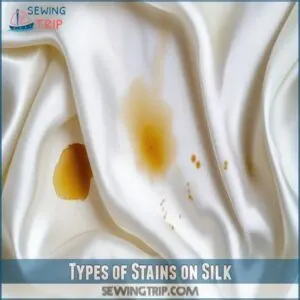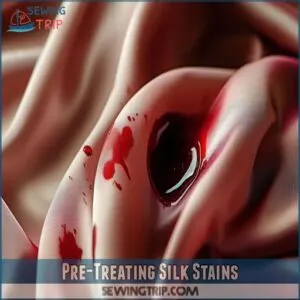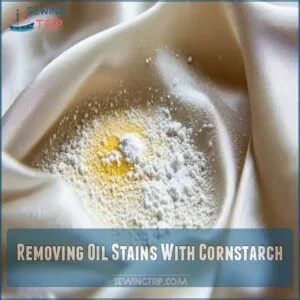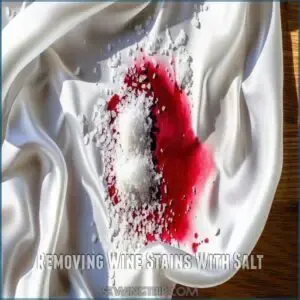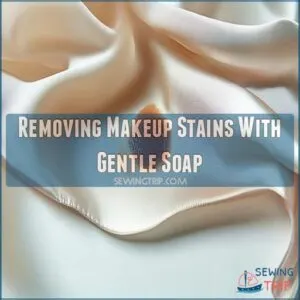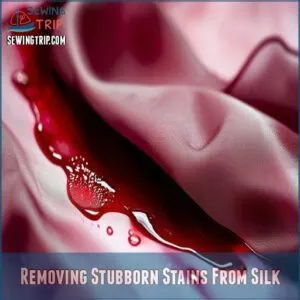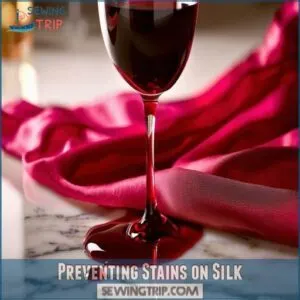This site is supported by our readers. We may earn a commission, at no cost to you, if you purchase through links.

First, blot the stain gently with a clean, white cloth—this isn’t the time for a rubbing marathon.
Mix a mild solution of lemon juice or vinegar with warm water, and dab the stained area lightly.
Rinse thoroughly with cool water, then lay the fabric flat to dry.
Think of it as a little spa day for your silk!
Always test any cleaning mix on a hidden part first, to avoid surprises like color fading.
Want to tackle tougher stains? Stick around for more expert tricks that’ll make you a silk-saving pro.
Table Of Contents
- Key Takeaways
- Types of Stains on Silk
- Removing Stains From Silk
- Pre-Treating Silk Stains
- Specialized Stain Removal Techniques
- Do’s and Don’ts of Silk Stain Removal
- Removing Stubborn Stains From Silk
- Preventing Stains on Silk
- Common Mistakes in Silk Stain Removal
- When to Seek Professional Cleaning
- Caring for Silk After Stain Removal
- Frequently Asked Questions (FAQs)
- Conclusion
Key Takeaways
- Act quickly by gently blotting the stain with a clean cloth, avoiding any rubbing to prevent spreading.
- Identify the stain type and use specific methods: cornstarch for oil, vinegar for wine, and mild soap for water-based stains.
- Avoid harsh chemicals and hot water, which can damage or set stains, opting for gentle and cool water solutions.
- For stubborn or delicate issues, consider professional cleaning to safely restore your silk to its original state.
Types of Stains on Silk
You’ll find that silk attracts five main types of stains: oil-based, water-based, makeup, food and drink, and ink marks.
While each type requires its own treatment method, you’ll be glad to know that most silk stains can be removed with the right technique and a bit of patience.
Oil-Based Stains
You’ve just spilled oil on your silk blouse – don’t panic! Oil-based stains are common culprits for ruining silk garments, but they’re manageable with quick action.
Here are the most frequent offenders:
- Cooking oil splashes while preparing meals
- Makeup and cosmetic products
- Body oils from skin contact
- Vehicle grease or mechanical lubricants
Prompt treatment is key – grab some cornstarch or talcum powder immediately to absorb the oil before it sets.
Water-Based Stains
While oil-based stains need specialized treatments, water-based stains on silk are a different beast altogether.
Coffee, tea, juice, and wine can quickly seep into silk fibers, leaving behind unsightly marks.
Here’s the good news: these stains are often easier to tackle than their oily counterparts.
Start by gently blotting the area with a clean, white cloth to absorb excess liquid.
Never rub the fabric.
Makeup Stains
From foundation to mascara, makeup stains on silk can seem like a beauty nightmare.
Start by scraping off excess product with a plastic card, then gently dab the area with a dry microfiber cloth.
For oil-based cosmetics like lipstick or concealer, sprinkle talcum powder to absorb the oils.
Tackle water-based products like powder foundation using a mild soap solution and cool water.
Food and Drink Stains
Most food mishaps on silk need quick action, just like those tricky makeup spills.
Here’s what you need to know about the most common culprits:
- Red wine and fruit juice leave bright stains that’ll set quickly without immediate blotting
- Coffee and tea create stubborn brown marks that need a gentle vinegar solution
- Greasy food spots, like butter or salad dressing, respond well to cornstarch absorption
Remember: The sooner you tackle these stains, the better your chances of saving your silk.
Ink Stains
Ink stains on silk can seem like a nightmare, but here’s the good news: you’ve got options.
Unlike food marks that might fade with time, ink needs immediate action.
Start by placing a clean white cloth underneath the stained area.
Then, dab (never rub!) the spot with rubbing alcohol using a cotton swab.
For stubborn marks, hairspray can work wonders – just test it first.
Removing Stains From Silk
Now that you’ve spotted the type of stain on your silk, it’s time to tackle it head-on.
You’ll want to work quickly but carefully – silk doesn’t forgive hasty decisions.
Start by placing a white cloth or paper towel beneath the stained area to prevent the stain from spreading.
Always perform a colorfastness test before applying any stain removal solutions to make sure you won’t damage the fabric.
For water-based stains, you can use a mixture of cool water and mild soap.
If you’re dealing with an oil-based stain, reach for cornstarch or talcum powder.
Remember, you’ve got options depending on what’s caused the mark – wine responds well to salt, while makeup might need a specialized silk cleaner.
Whatever method you choose, always test it on an inconspicuous area first.
And here’s a pro tip: never rub the fabric – gentle blotting motions are your best friend.
Pre-Treating Silk Stains
You’ll want to tackle that silk stain right away since waiting even a few minutes can make it harder to remove.
When working with delicate silk fabrics, it’s essential to understand the challenges of hemming techniques for silk, especially considering its slipperiness and tendency to fray. Before you reach for your usual stain remover, you’ll need to identify the type of stain and gather the right supplies to prevent damage to your delicate silk fabric.
Identifying The Stain Type
Every successful stain removal starts with proper identification.
When you spot a mark on your silk, take a close look at its characteristics: Is it oily and dark, or water-based and light?
Fresh stains often have distinct colors and textures, while older ones may appear dull or set-in.
A quick sniff can also help—food stains typically have lingering odors, while ink or makeup leaves telltale chemical scents.
Blotting The Stain
When you spot a stain on your silk, reach for a clean white cloth right away – time is of the essence.
Press down gently with the cloth to absorb excess liquid, working from the outside of the stain toward the center.
Never rub the fabric, as this can spread the stain and damage silk fibers.
Keep rotating to a clean section of your cloth until no more liquid transfers.
Applying a Cleaning Solution
Before applying any cleaning solution to silk, mix it to the right concentration – usually one part gentle detergent to four parts cool water.
For tough stains, consider using a quick treatment for silk stains, Quick Treatment for Silk Stains.
Test your solution on a hidden spot first, like an inside seam.
Using a clean white cloth, dab the solution onto the stain with light, circular motions.
Don’t saturate the fabric – you’re aiming for slightly damp, not soaked.
Specialized Stain Removal Techniques
You’ll need more than just water and soap to tackle those tricky stains on your favorite silk pieces.
Stubborn oil marks, red wine splashes, or makeup mishaps, these specialized techniques will help you restore your silk to its original beauty without damaging the delicate fabric.
Removing Oil Stains With Cornstarch
Oil stains on silk don’t have to spell disaster. You’ll find cornstarch in your kitchen cabinet works like magic to pull out grease spots. Simply sprinkle it generously over the stain and let it sit overnight. The powder acts like a sponge, drawing out the oil naturally.
- Press the cornstarch gently into the fabric with your fingertips
- Allow at least 8 hours for full absorption
- Brush away excess powder with a soft cloth
- Repeat if needed for stubborn spots
Removing Wine Stains With Salt
Just spilled red wine on your silk? Don’t panic!
While cornstarch works wonders on oil, salt is your secret weapon for wine mishaps.
Immediately pour a generous amount of table salt over the wet stain – it’ll absorb the wine before it sets.
Let it sit for 5 minutes, then gently brush away the salt.
For stubborn spots, repeat the process or try a 50/50 mix of white vinegar and water.
Removing Makeup Stains With Gentle Soap
Your silk’s makeup mishap doesn’t have to be permanent.
Mix a drop of gentle, pH-neutral soap (like Woolite or baby shampoo) with cool water until it’s slightly sudsy.
Using a white cloth, dab the solution onto the stain with light, circular motions. Don’t saturate the fabric – less is more here.
Once the stain lifts, rinse with clean water and pat dry with a fresh towel.
Do’s and Don’ts of Silk Stain Removal
You’ll need to handle your silk’s surprise spots with the same care you’d give a newborn butterfly, as one wrong move can turn a small stain into a permanent problem.
Stain removal might seem intimidating due to silk’s delicate nature, but you’re about to learn the expert-approved do’s and don’ts that’ll help you tackle those pesky marks with confidence.
Avoiding Harsh Chemicals
When dealing with silk stains, steer clear of harsh chemicals that’ll do more harm than good.
Bleach, chlorine-based cleaners, and strong detergents can permanently damage or discolor your precious silk pieces.
For tougher stains, consider a Quick Treatment for Silk Stains, which involves testing for color fastness and using gentle cleaning agents.
Instead, reach for natural stain removers like white vinegar, lemon juice, or mild soap.
These gentle cleaning agents effectively tackle stains while preserving silk’s delicate fibers and natural sheen.
Using Cool Water
Cool water proves to be silk’s best friend for stain removal and cleaning.
You’ll want to keep the temperature below 85°F to protect those delicate fibers from damage.
Forget what you’ve heard about hot water being better at cleaning – it actually causes silk to shrink and lose its natural sheen.
Stick to cool or lukewarm water to maintain your silk’s integrity and luster.
Avoiding Machine Washing
Tossing silk in the washing machine is like sending your favorite garment on a wild rollercoaster ride – it’s bound to end badly.
Machine washing can stretch, twist, and tear delicate silk fibers, even on gentle cycles.
Stick to hand-washing or professional dry cleaning to protect your silk investments.
If you must use a machine, place items in a mesh bag and select the coldest, gentlest cycle available.
Removing Stubborn Stains From Silk
You’ll need extra muscle to tackle those stubborn stains that just won’t budge from your silk garments, but don’t worry – we’ve got specialized techniques that really work.
Whether you’re dealing with set-in wine marks or tough oil spots, you can restore your silk using common household items like white vinegar, lemon juice, or a gentle detergent solution.
Using White Vinegar and Water
Three parts water to one part white vinegar creates your silk-saving solution. You’ll want to test this mixture on a hidden spot first, then gently dab it onto the stain with a clean white cloth.
- Mix the solution in a clean spray bottle for easy application
- Always use white vinegar, never apple cider or other types
- Apply with gentle, lifting motions rather than rubbing
- Let the solution sit for 3-5 minutes maximum
- Rinse thoroughly with cool water, blotting excess moisture
Using Lemon Juice and Water
Lemon juice packs a powerful punch against stubborn silk stains, similar to how its acidity can help break down tannins found in tea stains on clothes.
Mix one part fresh lemon juice with two parts water to create a gentle but effective solution.
Dab the mixture onto the stain with a white cloth, working from the outside in.
Let it sit for 5 minutes, then rinse with cool water.
The natural acids help break down the stain without damaging your silk.
Using a Mild Detergent
When silk’s delicate fibers meet stubborn stains, reach for a mild detergent specifically designed for silks, such as one available on the Silk detergent webpage like this gentle silk cleaner.
Mix one teaspoon with a cup of cool water and test it on a hidden spot first.
Using your fingertips, gently work the solution into the stain with circular motions.
Don’t rub too hard – silk’s sensitive nature means a light touch works best.
Rinse thoroughly with cool water.
Preventing Stains on Silk
You’ll save yourself hours of scrubbing and potential heartbreak by taking a few simple steps to protect your silk before those inevitable spills happen.
While you can’t wrap yourself in plastic every time you wear your favorite silk blouse, using the right tools and techniques, such as sewing silk fabric tips, can help minimize the risk of stains and extend the life of your garment. You can use a quality fabric protector and follow some practical habits that’ll keep your silk looking pristine longer.
Applying a Stain Repellent
Applying a stain repellent to silk is like putting armor on your favorite outfit.
It helps protect against those pesky spills.
Look for the best repellents designed for delicate fabrics.
- DIY options include a mix of water and fabric softener.
- Types of repellent vary, so choose wisely.
- Remember, application tips suggest reapplying every few washes.
Avoiding Eating and Drinking Near Silk
Imagine this: you’re at a dinner party, silk blouse on, chatting confidently. Then, oops! Red wine tumbles. When working with delicate silk fabrics, it’s essential to remember that silk is prone to fraying, so pre-washing and using suitable sewing techniques can help prevent damage. To dodge disaster, remember: silk care tips stress stain prevention. Avoid eating and drinking near silk; it’s delicate armor against spills. For tough stains, consider having a reliable silk stain remover on hand.
Here’s a quick guide:
| Tip | Benefit | Why It Matters |
|---|---|---|
| Use napkins | Keeps spills away | Protects from sauces |
| Hold drinks carefully | Reduces spill risk | Prevents stains |
| Sit back at tables | Avoids contact | Preserves silk’s beauty |
Washing Silk Regularly
Regularly wash your silk to keep stains at bay and embrace its natural shine.
Opt for a light detergent or soap specifically for delicate fabrics.
Stick with hand washing since machines can be too rough.
Choose your drying method carefully, ideally air drying, to preserve silk’s sheen.
This routine keeps your favorite silk pieces feeling and looking luxurious longer.
Common Mistakes in Silk Stain Removal
When dealing with silk stains, it’s easy to make mistakes like rubbing instead of blotting or using hot water, which can worsen the situation.
Avoid harsh chemicals that seem like a quick fix.
Remember that gentle handling keeps your silk looking sophisticated and stain-free.
Rubbing The Stain Instead of Blotting
Resist the urge to rub! That’s a common mistake; you’ll only spread the stain, causing more fabric damage. Instead, always blot gently.
Here’s how to avoid friction and master the proper technique:
- Blot gently with a clean cloth.
- Use a soft, absorbent material.
- Work from the outside in.
- Be patient; it takes time.
- Avoid harsh scrubbing motions.
Using Hot Water
Avoid Hot Water: Using hot water on silk is akin to pouring trouble over your favorite blouse. It causes shrinkage, fabric damage, or color fading—none of which are charming. Think of it as an uninvited guest that sets stains before you know it. Stick with cool water, it’s silk’s best friend.
| Hot Water Risks | Effect |
|---|---|
| Shrinkage | Tightens fabric |
| Color Fading | Dulls appearance |
| Fabric Damage | Weakens fibers |
| Stain Setting | Locks in stains |
Using Harsh Chemicals
Hot water isn’t your only foe.
Using harsh chemicals on silk is like inviting a bull into a china shop.
Sure, they promise to erase stains, but risk damaging the delicate fabric.
Bleaching, like removing satin stains, can be especially tricky and requires careful attention.
Embrace stain removal alternatives like eco-friendly options.
When in doubt, seek professional advice to keep your silk shining without nasty surprises.
Remember, Chemical Safety is key!
When to Seek Professional Cleaning
Sometimes, a stain on your cherished silk item just refuses to budge, making professional cleaning the best option.
If you’ve got a stubborn stain or a particularly delicate piece, trusting a professional dry cleaner can save your silk and your sanity.
Identifying Delicate or Valuable Silk Items
Knowing when to hand over the reins to a pro helps.
Delicate or valuable silk items often need special attention.
Look for:
- Silk fabric types: Rare weaves or exotic origins.
- Silk garment labels: When caring for your silk garments, it’s essential to understand the properties of genuine silk, such as its smooth and luxurious texture. Detailing professional care instructions.
- Price as indicator: High cost can signal delicate material.
Trust your instincts and keep cherished items pristine.
Recognizing Stubborn Stains
You might notice some stains on silk that just won’t budge no matter what you try.
Identifying stain types, considering the stain’s age, and noticing color bleeding can help you spot those troublemakers.
Here’s a quick guide:
| Factor | Impact | Tip |
|---|---|---|
| Stain Type | Oil, ink, or dye are stubborn | Seek pro help if home fixes fail |
| Stain Age | Older stains set deeply | Act fast, or reach out for help |
| Color Bleeding Risk | Silk dyes might bleed during attempts | Test small, hidden areas first |
| Stain Location | Visible spots affect usability | Prompt cleaning is key |
| Stain Removal Limits | Frustration with tricky spots | When in doubt, call the pros |
Finding a Professional Dry Cleaner
Finding a really good dry cleaner is like finding the best babysitter.
You want certifications and rave reviews, showing they know their stuff.
Check local dry cleaner reviews online and compare costs to get the best bang for your buck.
Don’t skimp on expertise; a trustworthy pro makes sure your delicate silk remains pristine and effortlessly stylish!
Caring for Silk After Stain Removal
Now that you’ve successfully removed the stain, proper drying and storage are key to keeping your silk looking its best.
Gentle air drying, careful ironing (if needed), and storing it away from light and moisture will help prevent future issues and maintain that luxurious feel.
Drying Silk Properly
Drying silk properly can feel like a balancing act, but it’s doable! Here’s a quick guide:
- Flat Drying: Lay your silk flat on a clean towel to air dry. This prevents stretching.
- Avoid Hanging: Hanging silk can lead to wrinkles and distort the fabric.
- Gently Press: Use another towel to press out excess water, being careful not to wring it.
Ironing Silk Safely
A well-reacted approach to ironing silk keeps elegance intact.
Set your iron to a low temperature to avoid scorching, and activate steam settings for gentle wrinkles.
Use pressing techniques that involve a cloth between the iron and fabric, preventing damage.
Different silk types demand unique care, so be attentive.
An ironing board provides a steady surface for precision.
Storing Silk to Prevent Future Stains
After ironing your silk safely, let’s talk storage.
Storing silk properly involves using cedar to prevent moths, wrapping items in acid-free paper, and placing them in airtight containers, such as high-quality cedar storage boxes online.
These tricks don’t just protect against stains; they extend the life of your silk treasures.
Keep these delicate items pampered and pristine, ready for their next glamorous outing.
Frequently Asked Questions (FAQs)
How do you get stains out of silk?
Who knew owning silk was like babysitting?
To tackle stains, dab with a clean cloth, treat oil with cornstarch, mix vinegar and water for tough spots, rinse gently, and let air-dry.
Avoid scrubbing, seek help if needed.
Can Silk be stained?
Yes, silk can be stained, unfortunately. Spills happen! Act fast; blot, don’t rub. Know your enemy: oil needs powder, wine needs vinegar. For tough stains, a pro’s the best bet.
How do you remove oil stains from silk?
Got an oil stain on silk? Don’t panic.
Sprinkle cornstarch or talcum powder, let it sit to absorb the oil, then gently brush it off.
Repeat if needed, and avoid rubbing to prevent spreading the stain.
What happens if you remove a stain from silk?
Removing a stain from silk can make the fabric look as good as new, but if you’re too aggressive, it might lead to damage like color fading or material weakening.
Always test solutions on a hidden area first.
How to remove sweat stains from silk?
When life gives you sweat stains on silk, whisk them away by blotting gently with a water-vinegar mix.
Test on a hidden spot first, then rinse gently with cool water, letting the silk air dry for best results.
How do you remove stains from a silk shirt?
To remove stains from a silk shirt, blot gently with a clean cloth.
Use a mild detergent mixed with cool water and work in circles.
Rinse thoroughly, air dry, and avoid scrubbing to prevent damage.
Can I use bleach on silk stains?
Using bleach on silk is like inviting a bull into a china shop—it’s a disaster waiting to happen.
Bleach can weaken silk fibers, causing damage.
Stick to gentler methods, like mild detergents, to treat stains safely.
How does sunlight affect stained silk?
Sunlight can set stains on silk, making them harder to remove.
It might also cause discoloration or fading.
Shield silk from direct sunlight to keep its color vibrant and prevent those stubborn stains from becoming permanent.
Is oxiclean safe for cleaning silk?
Did you know 90% of silk stains are preventable? OxiClean’s harsh chemicals can damage delicate silk. Stick to gentle detergents or seek professional cleaning; your silk will thank you!
Does steaming help remove silk stains?
Steaming won’t directly remove stains from silk, but it can help lift odors and wrinkles.
For stains, you’d need specific treatments with mild detergents or vinegar solutions.
Always test on a hidden area first to prevent damage.
What temperature water should I use?
Use cool water when washing silk to avoid setting stains and damaging the fabric.
Hot water can cause silk to shrink and lose its shine, so keep it gentle with a mild detergent for best results.
Conclusion
Dealing with silk stains is like coaxing a shy cat—gentle, patient, and mindful.
By understanding different stain types and using suggested techniques, you can master how to get a stain out of silk without causing damage.
Stick to cool water, mild solutions, and always test first.
Preventing stains by handling silk with care is easier than removing stubborn ones.
If all else fails, professional help is always an option to keep your silk looking pristine.

